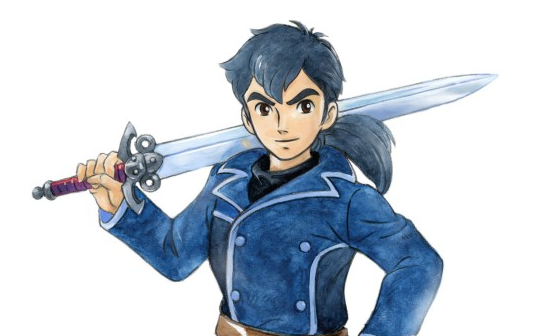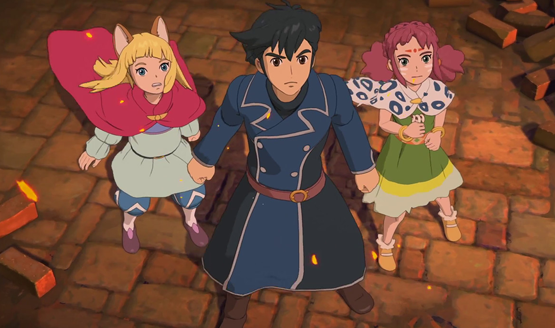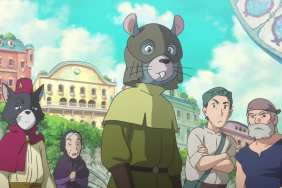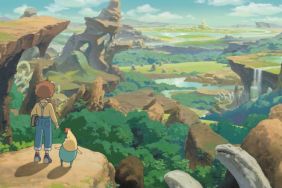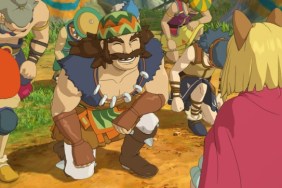Ni no Kuni II: Revenant Kingdom is the story of Evan, a young boy usurped from his impending throne. A coup led by the King’s adviser, Mausinger, left the king dead and the boy without a kingdom. Or that’s what every bit of marketing would have you believe. Upon closer examination, Evan’s troubles are simply a canvas for Roland’s story, something that becomes increasingly clear before the game’s credits roll. Though Ni no Kuni II isn’t a direct sequel to the first game, there are some parallels that can be drawn to Oliver’s journey that really highlight Roland’s growth and importance to the story.
Spoiler Warning: It’s impossible to talk fully about Roland’s role within Ni No Kuni II without getting into the game’s conclusion. From here on out, there are spoilers for both Ni no Kuni and Ni no Kuni II’s endings.
From the outset, I took a particular liking to Roland. He’s the only character who is with Evan from the very beginning. In fact, players actually find themselves in control of the mysterious outsider before they ever gain control of Evan. Ni no Kuni II: Revenant Kingdom opens with a grey-haired and stoic looking Roland, president of a world that appears to be our own, in the back of a limo as a nuclear missile flies by overhead. The screen goes white and a younger, quite confused Roland stands in Ding Dong Dell just in time to save Evan from the coup that killed his father.
The story in Ni no Kuni: Wrath of the White Witch centered around souls between our world and the world of Ni no Kuni being inextricably connected. The game begins in the real world with Oliver shortly after his mother’s death and he then travels into Ni no Kuni as a stranger to the land. Eventually he becomes the hero that the world needs after discovering that his soul is linked with one of the game’s main villains. After helping to defeat the evil in the world, Oliver bids his friends farewell and returns to the real world.
When I got the option to change my party, I set Roland as my lead and never budged. I just felt a connection to him that I couldn’t explain. Of the initial trio (Roland, Evan, and Tani), he is the only adult, and his mystery endlessly intrigued me. Despite being confused by the situation, he quickly helps to set Evan on his path without fully taking charge himself, which he could have quite easily done. Where Evan’s growth as a character is on display during the entire game, Roland’s is a quiet internal character development.
Echoes of Oliver
At a glance, it might seem like Evan is Oliver’s echo for the sequel. Evan loses his father before the start of the game and both are children beset with immense responsibility. He’s been front and center for marketing and even wears a red cape, just like Oliver did in the first game. However, what if we compared Roland to Oliver? He comes from the “real world,” ending up the only outsider within Ni no Kuni. He loses something at the beginning of the game too. From an obvious perspective, he loses his entire nation to war. Near the end, it’s revealed that Roland feels that he failed his son by failing as a leader. An entire nation may be ash, but that means Roland’s family is dead too.
About halfway through the story, the Kingdom of Evermore needed to ferret out a traitor in their midst. All indications pointed to Roland being that traitor, but no! Not my Roland! I refused to believe that he would betray Evan and Evermore, but mystery still surrounded Ni no Kuni II’s outsider. Perhaps I misread him. When Roland walks away from Evermore, I was heartbroken, but I was soon in control of the “traitor” walking in to Ding Dong Dell to sell state secrets to the highest bidder. It’s revealed to be a setup so that Roland can obtain Evan’s pendant, but this is the only time in the game when you are specifically put in control of a particular character other than Evan.
During Ni no Kuni II’s climax, Doloran (the true villain) is revealed to be connected to Roland’s soul in this realm. Roland and Doloran’s connection is the only reference we have to something that was central to the entire story in Ni no Kuni. Strong emotional incidents for these characters drew Roland into this world, and he sees himself as distinctly opposite of Doloran’s approach of destroying lives for love. In fact, it’s Roland who talks Doloran down and convinces him to see reason.
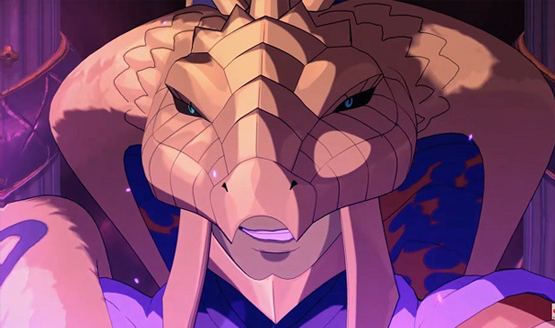
Evan is an ambitious young king with the goal of uniting the kingdoms of the world under a peaceful banner, but it’s Roland who saves the land of Ni no Kuni from complete and utter destruction. When Evan finally unites the kingdoms, Roland steps up and does what he was brought to Ni no Kuni to do. He confronts this world’s dark reflection of himself. He remains strong, vigilant, and he takes what he learned back to the real world. Our final look at Roland mirrors the opening scene. He talks with an aide of uniting the nations, a seemingly impossible task that has never been done before. Roland smiles and tells him that it has been done before, in a country far away. Instead of missiles flying overhead, we see fireworks welcoming Roland’s arrival.
Just like Oliver, Roland learns the lesson he needs to learn from Ni no Kuni and departs back to the real world, stronger for his experience. It’s a bittersweet ending. Was any of it real? Did saving Ni no Kuni change Roland’s fate in the real world? It was real to Roland, and that’s all that matters.
Roland the Revenant
Our final hint that Ni no Kuni II is actually Roland’s story is the subtitle—Revenant Kingdom. Revenant is defined as something or someone that has returned, specifically from the dead. Neither Evan nor the kingdom of Evermore fit that description. In the end, we discover that Doloran is trying to revive Allegoria from death, which certainly fits the literal definition of Revenant Kingdom, but let’s once again turn our eye to Roland.
It can be assumed that Roland dies along with everybody else in the blast at the beginning of the game. His younger appearance makes it quite clear that it’s not entirely the same Roland that gets transported to Ni no Kuni. It’s our first look at revenant Roland, a man returned from death as a stranger in a strange land. We also see his nation–or kingdom–obliterated by a missile, and Roland later talks about how his kingdom had died in war and flames. When we see Roland back in the real world, his dead nation has been restored, a revenant kingdom.
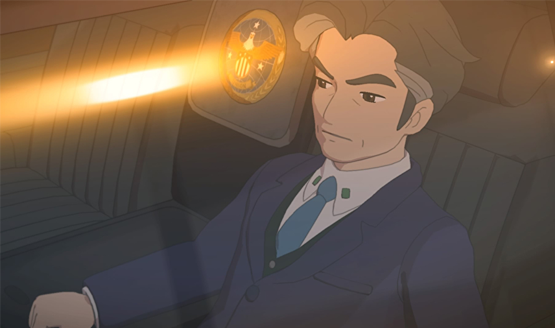
I’m not trying to steal any light or credit from Evan. He has a wonderful story arc with a very obvious development path as he goes from boy without a kingdom to the one who unites nations. Roland is our deeper connection to this world though, reminding players of the rules of Ni no Kuni. Evan is a child coming into his own greatness. Roland is an old man who has already achieved leadership pondering who he is and how his character has developed. While Evan grows, Roland reflects. His time away from the familiar gives him the opportunity to see himself and his position in a new light.
Did Roland actually die? Was his nation destroyed? Was Ni no Kuni a dream? The answers to all of these questions are left ambiguous. Ni no Kuni has been known to dabble in elements of time travel, and Evan’s story even has a thread that concludes with some time manipulation, so it’s entirely possible. Whether Evan, Evermore, and the rest of Ni no Kuni are real or not doesn’t actually matter though. The experience allowed Roland, an old man responsible for the lives and happiness of many, to reflect. His silent pensiveness from the opening begins to slip away in the end, a revenant of a man who will not fail his family or his kingdom. Roland accompanied Evan on his journey, but the story was all his.
If you haven’t read our Ni no Kuni II: Revenant Kingdom review, check out why we called it a near-perfect RPG. We also have a number of guides you can find in the Ni no Kuni II hub.
